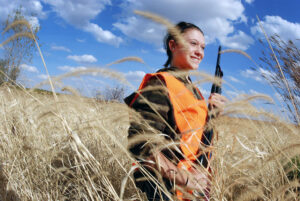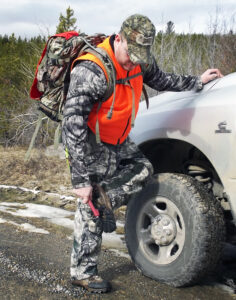Erika Segerson-Mueller, DNR Invasive Plant Program Specialist, Oshkosh Service Center Erika.SegersonMueller@wisconsin.gov or 715-492-0391

Whether you are headed out to a tree stand in your favorite local forest or a duck blind on the shore of your nearby pond, you can take a few easy precautions to help minimize the spread of invasive plants in your favorite hunting spots. / Photo Credit: NAISMA.org
Heading out to your tree stand or hunting blind this fall? Avoid adding invasive species to your hunting party by taking a few simple steps to help protect your woods.
Non-native invasive plants often outcompete native plants in forest environments, degrading diversity and destroying wildlife habitat. Invasive plants can replace local forest species and may interfere with or decrease tree regeneration. They may take over woodlands, prairies and wetlands, and many provide ideal habitats for pests that harm wildlife and people alike.
Invasive plants are often not palatable to local wildlife, reducing natural forage because animals like deer prefer native plants. This can create a domino effect and cause deer to migrate away from their usual habitats in search of more food. Besides these downsides to your hunting season, learn more about why we should care about invasives from economic, ecological and human health perspectives.

Hunters can help slow the spread of invasive plants by brushing off boots, gear, pets and vehicles before and after a hunt. / Photo Credit: NAISMA.org
Although invasive plants are easily spread by seeds on vehicles, boots and other gear, there are a few precautions you can take to avoid spreading invasive plants this hunting season:
- Inspect your clothes, vehicle, gear and dogs both before and after each hunt.
- Pack a boot brush in your vehicle so you can easily remove plants, seeds and mud from your boots and gear before leaving the site.
- If possible, park in non-vegetated areas to avoid carrying seeds on your vehicle.
- Learn to identify the invasive species common to your area so you know what to look for on your next hunting trip and can better aid in slowing the spread of invasive plants.
Learn more about best management practices for hunters and trappers on this DNR fact sheet, or check out all the Best Management Practices for outdoor recreationists on the Wisconsin Council on Forestry’s page.
Invasive species threaten the future of hunting and fishing. Defend your favorite places by taking these precautions and helping to slow the spread of invasive plants on your next hunt.
